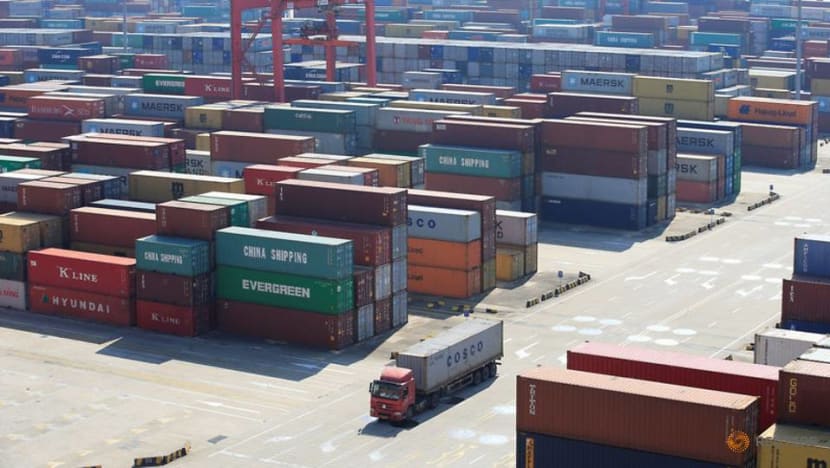commentary Commentary
Commentary: Don't be too quick to dismiss the economic benefits of RCEP for Southeast Asia
Reductions in tariffs on goods, which benefit China, are often overestimated in such calculations, whereas reduction in barriers impacting services, which favour ASEAN, are undervalued, says Deborah Elms.

The Regional Comprehensive Economic Partnership (RCEP) includes China, Japan, South Korea, Australia, New Zealand and the 10 members of ASEAN. (File photo: AFP/STR)
SINGAPORE: What is the economic impact of a huge new regional trade agreement for participating countries?
ASEAN member states are currently re-examining this question after a new report out of the UN Commission on Trade and Development (UNCTAD) suggested that the Regional Comprehensive Economic Partnership (RCEP) could be harmful to many in the region.
The report, released two weeks ago, posited that under the RCEP, ASEAN countries will see a decline in their balance of trade as they are likely to import more goods than export to other RCEP member countries, especially China, which, as a more efficient exporter, may benefit from trade diversion.
The conclusions of this report are highly likely to be wrong. ASEAN will find new economic stimulus coming from being part of the world’s largest free trade agreement with 15 members across Asia.
GOOD ESTIMATES ARE HARD TO ACHIEVE
Often, poor modelling results in poor judgements about the impact of trade agreements. But getting good estimates of the impact of any trade deal is much harder than might be appreciated.
Typically, the easiest element of a free trade agreement (FTA) to see and measure is reductions in tariff rates. All FTAs work to lower tariff rates at the border as a way of helping provide benefits to participating members and lowering costs. A reduction in tariffs should stimulate greater trade flows.

Not every good that might appear to be eligible for tariff cuts will actually qualify for these benefits. Products have to be manufactured in ways that fit the criteria for each trade agreement and include sufficient content from within member states.
As an example, hand soap that contains a high percentage of imported content may not be eligible for claiming lower tariffs that otherwise appear to be on offer.
Even if a product qualifies, firms have to apply for lower tariff rates as the FTA preferences are not granted automatically.
As a result, no FTA has ever achieved complete tariff liberalisation where all goods entering the country as part of an FTA agreement are granted free or reduced tariffs.
READ: Commentary: The Quad has a plan and it’s not all about China
READ: Commentary: What the stuck ship in the Suez Canal taught us about life
However, economic modelling typically assumes that every potentially eligible good currently captured by trade flow statistics will receive whatever tariff benefits that are promised in the deal.
Models are also normally based on existing trade profiles. In other words, to get at the economic impact of tariff reductions and elimination, a model starts with existing trade information. However, one key point of an FTA is to unleash new opportunities for trade and to improve on existing trade agreements or frameworks.
Products that used to face significant tariffs were unlikely to show up in existing trade flow details or, if such goods were traded, the total volume of trade was likely to be small.
For example, if shampoo, frozen seafood, or children’s pyjamas were charged 15 per cent to 20 per cent tariffs in the pre-FTA world, firms making such items would probably not have sold much. If tariffs drop, companies might suddenly find significant new demand in the partner market.
But such new trade flows in shampoo, seafood or apparel will not show up in the economic modelling of existing FTAs, as UNCTAD has done, as they are new gains that will only kick in later.
TARIFF REDUCTIONS MAY BE OVERWEIGHTED
Determining the impact of the RCEP or any FTA also depends on existing conditions in other ways.
Asian governments, including ASEAN members, have been enthusiastic participants in FTAs.

RCEP itself was built on the basis of five existing ASEAN+1 trade agreements that have been combined and refashioned into one. The net result is that there are literally hundreds of different types of trade arrangements that cross the region from bilateral commitments to large regional deals.
RCEP benefits – even for assessing just tariff cuts – therefore depend on comparing RCEP to other existing trade deals.
Firms might already be enjoying duty-free treatment for their products under other FTAs, like ASEAN-China. Economic models that look at the RCEP in silo, as the UNCTAD study has done, therefore struggle to capture this level of complexity.
In addition, all FTAs include phased-in commitments. In other words, tariff cuts are not instantly granted for all products, but often gradually adjust over time.
Hence comparing FTA benefits to RCEP commitments requires a careful assessment of timing. The first day or entry into force for RCEP may not compare favourably to existing FTA benefits, but after tariffs are fully implemented, the differences could be substantial.
Tariffs are always overweighted in economic models as they are easiest to see and count. But RCEP, like other comprehensive FTAs, includes significantly more than just tariff reductions.
READ: Commentary: Suez Canal incident reveals why global trade depends heavily on shipping with few alternatives
READ: Commentary: Why the Suez Canal accident is a worst-case scenario for global trade
Changes in customs procedures, to name just one element of RCEP, can have an even greater impact on a firm than a reduction in tariffs as the cost of delays at the border can be quite high and often hit the bottom line more than a tariff rate adjustment.
A commitment to move trade documentation online or clear express cargo within 6 hours could turn out to be the most important point of RCEP for many companies.
The services and, especially, investment commitments embedded in RCEP are substantial but hard to show in many models. Data on services trade is not great. Understanding how new market access or improved protection of investments might matter to firms is especially difficult.

How can a model decide what benefit to assign to improved market access for landscape architects or preschool education providers or graphic designers? How valuable is better clarity on investment rules?
While firms are likely to appreciate many of the elements in RCEP, economic modeling done by UNCTAD understates or ignores these aspects of the agreement, which does not allow one to get a comprehensive view of the overall benefits provided by the RCEP.
READ: Commentary: Is Southeast Asia on track for post-pandemic recovery?
In short, it seems clear that RCEP will deliver economic benefits to participating member states. Exactly capturing and quantifying the likely boost in trade and economic growth for any given member or specific sector is very hard to achieve.
Economic models that claim to do so with authority should be taken with a large handful of salt.
Dr Deborah Elms is Executive Director, Asian Trade Centre, Singapore.















